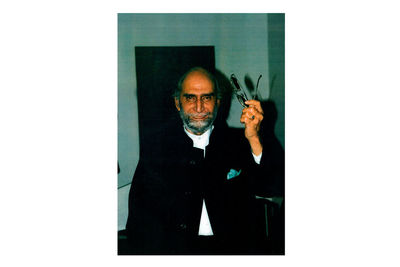The use of furniture in the daily life of Iranians was once limited only to the nobles and the rich. Carpenters who came to Iran from Hungary made furniture for the nobles, and those who studied abroad returned with noble sofas and hired carpenters to make sofas based on those experiences. This work was called "Lenge-Sazi" - pair making - however the sofas that were made were mostly in Rococo style. Iranian carpenters copied these sofas and sometimes made changes in them, but there was still no interior design in Iran.
Eduard Khachaturian, who studied in France, started producing furniture based on European designs in the 1930s and 1940s by hiring a carpenter and using European architectural magazines, at the same time, he also implemented his own designs. Edward was an Iranian-Armenian, who also loved the culture of the East, and he can be considered one of the first interior designers and architects of Iran. He was very interested in art and bought the works of people like Marko Gregorian and used them in interior decoration.
In the 1950s, the famous Spanish architect Ricardo Bufil built a house in the West settlement, but he could not complete the project due to the time of the Islamic Revolution. After that, Edward Khachatourian was introduced to him to continue the interior design work of the house, and the work he did remained as a brilliant work in Khachatourian's career. Among Edward's other works, we can mention the Iranian Senate, the design of the Iranian parts of Saadabad and Niavaran palaces.

Edward gradually abandoned the sofas that were inspired by modern Italian, French, Chinese, Japanese and Indian models and for the first time designed sofas in which he used Iranian elements. Only a few examples of each of these designs were made, which had specific customers. He went through a difficult path to make original furniture, which required going through a difficult and exhausting design process, spending money and discovering and building the taste of the audience, but in the end, he created a collection of works that fit the spirit and lifestyle of Iranians. The brand of Edwards had a lot of trials and errors in this path from the past until today. From quasi-Russian designs to turning towards Southeast Asia, the introduction of Iranian animals such as rams and lions into the works or even the thickening of the base of the sofas to fit more with the ergonomics and lifestyle of Iranians are among these.

Another important action of Eduard Khachatourian was the use of Russian wood or beech in making furniture. At that time, furniture was made with walnut or oak wood, and due to its high price, only the nobles could afford sofas. But Edward was interested in the fact that the majority of people could afford furniture, so he introduced beech wood into the furniture industry so that the final cost of the work was much lower. Also, with this decision, Edward increased the life of the products and the tradition of using beech wood is still prevalent in the Iranian furniture industry. When Edward was at his peak, he took his son Ariona, who was five years old, with him to places like Saadabad Palace or Niavaran, and from there Ariona got to know about this work.
At the same time, Edward sent his son to study in France, and he went to the Louvre University and the University of Fine Arts in Paris, so that by learning French architecture and art, he could combine it with the background of Iranian knowledge, culture and art.
Ariona Khachatourian, following in the footsteps of his father, developed and modernized the Edwards brand and used all these learnings and experiences in projects such as the Edwards building, the reconstruction of the Iranian part of the Saadabad complex, which was once designed and built by Edward the father, some embassies and also a number of See the best penthouses today.
Ariona Khachatourian has also made technical and artistic innovations in furniture design, and some of the furniture designed by him have reached to customers from Europe and North America. At Edwards, he moved the issue of design from furniture to architecture and interior architecture, and thus today Edwards brand is able to present modern designs inspired by Iranian culture, relying on more than seventy years of knowledge, experience and brilliant history.

